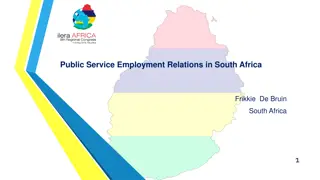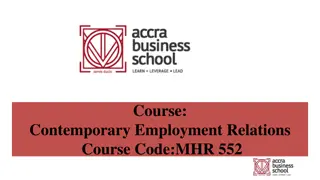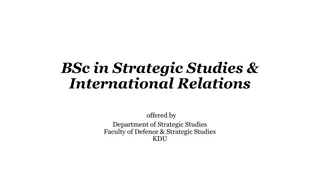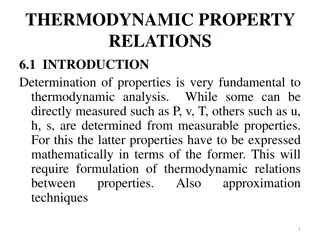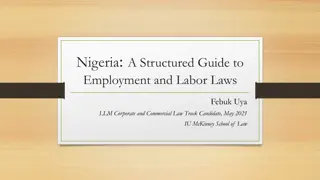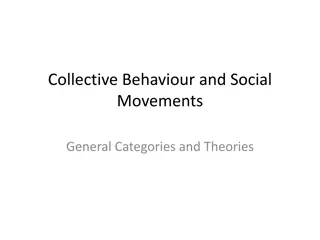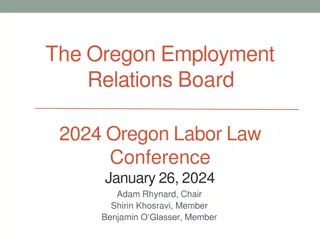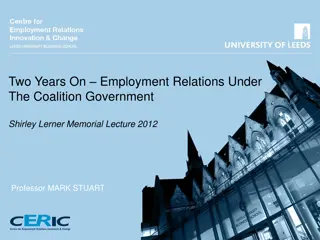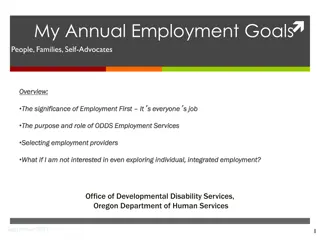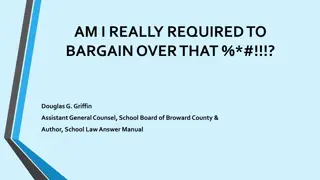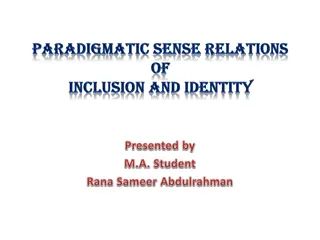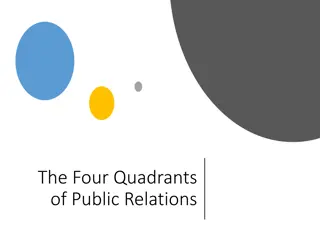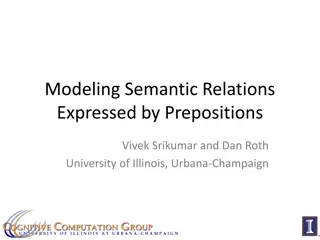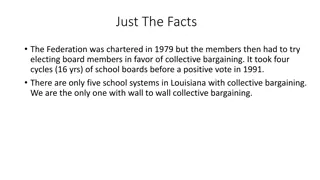Understanding Collective Employment and Industrial Relations
Collective employment involves negotiations between employers and employee representatives to establish working conditions, wages, and more. These agreements, known as collective bargaining agreements, are crucial in defining the terms of employment. International conventions recognize the right to bargain collectively as a fundamental human right. Through trade unions, employees can voice their desires and concerns in a cooperative or, in some cases, confrontational manner to reach mutually beneficial agreements.
Download Presentation

Please find below an Image/Link to download the presentation.
The content on the website is provided AS IS for your information and personal use only. It may not be sold, licensed, or shared on other websites without obtaining consent from the author. Download presentation by click this link. If you encounter any issues during the download, it is possible that the publisher has removed the file from their server.
E N D
Presentation Transcript
UNIT 7: COLLECTIVE EMPLOYMENT AND INDUSTRIAL RELATIONS
Collective negotiations between employers and the representatives of a unit of employees aimed at reaching regulate working conditions. Collective agreements usually set out wage scales, working hours, training, health and safety, overtime, grievance mechanisms and rights to participate in workplace or company affairs. bargaining is a process of agreements which
The union may negotiate with a single employer (who is typically representing a company's shareholders) or may negotiate with a group of businesses, depending on the country, to reach an industry wide agreement. A collective agreement functions as a labour contract between an employerandoneormore unions. Collective bargaining consists of the process of negotiation between representatives of a union and employers (generally represented by management, in some countries by an employers' organization) in respect of the terms and conditions of employment of employees, such as wages, hours of work, working conditions and grievance- procedures, and about the rights and responsibilities of trade unions. The parties often refer to the result of the negotiation as a collective bargainingagreement
Typically, the employees are represented by a trade union. Collective bargaining actually begins with: 1. joining a union; 2. agreeing to abide by the rules of the union; and 3. electing union representatives. Thus, in general, experienced people from the union will assist the employees with putting together a draft of a contract, and will help them present their desires to the company. Numerous meetings between representatives of employer and employees will be held until the two can agreeonacontract.
As the contract is being negotiated, general employees also have input on it, through their union officers. Thus, the agreement reflects the combined desires of all the employees, along with limitations that the employer wishes to see put in place. The result is a powerful document which usually reflects cooperative effort. In some cases, however, the union or the employer may resort to antagonistic tactics such as striking or creating a lockout,in order topushthe agreementthrough.
The right to collectively bargain is recognized through international human rights conventions. Article 23 of the Universal Declaration of Human Rights identifies the ability to organize trade unions as a fundamental humanright. Item 2(a) of the International Employment and Industrial Relations Organization s Declaration on Fundamental Principles and Rights at Work defines the "freedom of association and the effective recognition of the right to collective bargaining" as an essential rightof workers.
In the Canadian case of Facilities Subsector Bargaining Association v British Columbia [2007] 2 S.C.R. 391, the Supreme Court of Canada extensively reviewed the rationale for regarding collective bargaining as a human right andmadethe followingobservations: The right to bargain collectively with an employer enhances the human dignity, liberty and autonomy of workers by giving them the opportunity to influence the establishment of workplace rules and thereby gain some control over a major aspect of their lives, namely their work...
Collective instrument for pursuing external ends rather [it] is intrinsically valuable as an experience in self-government... Collective permits workers to workplace democracy and to ensure the rule of law in the workplace. Workers gain a voice to influence the establishment of rules that control a major aspectof their lives. bargaining is not simply an bargaining form achieve a of
Section 66 of the ILRA sets out the procedure for reaching a collective agreement, through collective bargaining between trade unions and employers or employer organisations, as thecasemaybe.
Section 66(2) ILRA: Collective bargaining may be undertaken- (a) at the level of an undertaking, through negotiations between the management of the undertaking and the trade unionrepresenting theeligible employees; or (b) at the level of an industry, though negotiations between the employers' organisation representing the eligible employees. and the trade union (3) Every validcollective agreement inforce prior to the commencement of this Act shall continue in force until its expiry or replacement under thisAct.
Section 68 ILRA: Every collective agreement shall contain clauses, in this part referred to as statutory clauses,stipulating- (a) the date on which the agreement is to come into effect and the period for which it is to remaininforce;and (b) the methods, procedures and rules for reviewing, amending, replacing or terminating thecollectiveagreement.
Section 70(1)ILRA: The parties to a collective agreement shall, within fourteen days of signing, lodge five signed copies of the collective agreement with theCommissioner. (2) The Commissioner shall, within fourteen days of receipt of the copies referred to in subsection (1), submit such copies, together withhiscommenttotheminister.
A collective agreement lodged or file for approval to the Labour Commissioner, may be disapproved, pursuant to section 71(1)(a): Section 71 (1)(a) ILRA: The Minister may,after considering acollective agreement lodged in accordance with section seventy together with the comments of theCommissioner received under subsection (2)- (a) direct that a copy of the collective agreement be returned to the parties together with his reasons for not directing the registration andgive instructions tore-submit the collective agreement totheCommissioner; or
A collective agreement lodged or file for approval to the Labour Commissioner, may be approved, pursuant to section 71(1)(b) and section71(2): (b) direct the Commissioner to register the collectiveagreement. (2) The Minister shall not direct the registration of a collectiveagreementunless he issatisfied that- (a) the agreement contains the statutory clauses referredtoin section sixty-eight;and (b) the clauses in the agreement do not contain anything which is contrarytoany writtenlaw
Once a collective agreement has been approved by the Minister, it commences or comes into effect in accordance with the provisions of section71(3) ILRA: (3) Every collective agreement which has been approved by the Ministershall- (a) come into force on the date on which it is approved or on a later date specified in the collectiveagreement; (b) remain in force for such period as shall be specified in the agreement; (c)be binding on thepartiestoit
There incorporation individualcontractsofemployment. are two of theories collective regarding terms into
The first one is known as the concept of automatic incorporation. Under this concept, it is assumed that the collective terms are incorporated automatically into individual contracts of employees in the enterprise or industry in which the collective agreement is in effect as soon as the agreement becomes legallybinding.
The other theory is that there is no automatic incorporation of collective terms but that parties employment must consciously incorporate the said terms in employment. to the contract of their contracts of
In the case of Contract Haulage Limited v Mumbuwa Kamayoyo (1982) Z.R. 13 (S.C.), the Supreme Court held that a collective agreement is a legally binding contract between the parties and that anything done outside these contractual agreements are of nolegaleffect.
What is a strike? Section 3 of the ILRA defines strike to mean: "strike" withdrawal of labour contrary to the terms and conditions of a contract by a body of persons employed in any undertaking combination; or a concerted refusal or a refusal under a common understanding of any number of persons who are so employed to continue to work or provide their labour means the cessation of work or acting in
What is a lock out? Section 3 of the ILRA defines lock out tomean: The closing down of a place of employment or the suspension of work by the employer, or the refusal by an employer to continue to employ any number of persons employed by him, as a result of a dispute, and done with a view of compelling those persons, or to aid another employer in compelling those persons, or to aid him, to accept terms or conditions affecting employment.
Strikes recognized as legitimate actions that may be undertaken by workers or employers in furtheranceoftheirdispute. However, such actions become lawful only if they are resorted to after due process and only if they do not involve essential services . and indeed lockouts are both
The Act sets out detailed procedures to be followed in resolving disputes before a strike or lockout can be declared. Firstly, section 6 of the Industrial and Labour Relations Act provides that: Every employee shall promote, maintain and co-operate with the management of the undertaking in which the employee is employed in the interest of industrial peace, greater efficiency and productivity. Therefore, before reaching any decision to go on strike, employees have a duty to co-operate with management to resolve any dispute.
What is a collective dispute? Section3ILRA provides: "collective dispute" (interpreted)in accordancewithsection seventy-five. shall be construed
75. A collective dispute shall exist when there is a dispute between an employer or anorganisation representing employers onthe one hand and the employees or an organisation representing the employees on the other hand, relating to terms and conditions of, or affecting the employment of,the employees andone partytothe dispute has presented in writing to the other party all its claims and demands and- (a) the other partyhas, within fourteen daysfrom the dateof receipt of the claims or demands,failed toanswer the claims or demands;or (b) the other party has formally rejected the claims or demands and has made nocounter offer; or (c) both the parties to the dispute have held atleast one meeting with aviewtonegotiating asettlement ofthe dispute, buthave failed to reach settlement on all or some of the matters in issue between them
Section 78 ILRA sets out the next course of action where parties fail to settle a collective dispute.
78. (1) Where a conciliator or board of conciliation fails to settle a collective dispute thepartiesto thecollectivedisputemay- (a)referitto theCourt; or b) conduct a ballot to settle the dispute by a strikeor lockout.
Referal of the dispute to court-S78(2): (2) Where a collective dispute is referred to the Court under subsection (1) or under subsection (6) of section seventy-six the decision of the Court shall, subject to section ninety-seven be binding upon the parties to the dispute for such periodastheCourt mayspecifyintheOrder.
Conduct of a ballot to strike or lock out- S78(3) ILRA (3) Where the parties, decide to proceed on strike or lockout, the parties shall not proceed on strike or lockout unless a simple majority decision of the employees present and voting is made by employees in favour of the strike or lockout. Note that, the voting weight for simple majority is 50%+ 1
(4) The strike or lockout may, subject to section seventy-five, commence ten days following the decision to do so and may continue for an indefinite period during which the dispute remains unresolved.
The rule in Kitwe City Council v. William Ng uni, was to the effect that an employee cannot get paid for a period that he has not worked. Thus, by extension, when employees embark on a strike, because they are not working, the employer is entitled not to remunerate them for the period they do not report towork.
Who is entitled to the right to strike? It is important to note that the right to strike is strictly limited to parties to the dispute. This therefore means that sympathy strikes over political matters are not legitimate under the law. It is also important to note that no strike may take place after the Industrial Relations Court has given a decision. Certain protective provisions incorporated in the Industrial Relations Act. have been
A strike cannot commence before the collective dispute is referred to conciliation pursuant to section 78 ILRA. If the parties fail to reach a settlement agreement within the stipulated time frames, either party may refer the dispute to the court, conduct a ballot to settle the dispute by strike or lockout, or refer the matter for arbitration.
Article 3(1) and (2) of the ILO Convention No. 87 providesthat: Workers organisations shall have the right to ... organize their ... activities and to formulate their programmes. The public authorities shall refrain from any interference which would restrict this right or impede the lawful exercise thereof.
Notwithstanding the enshrinement of the right to strike and wide ambit given to freedom of association, the ILO, through these supervisory bodies, has affirmed the principle of the right to strike subject to restrictions that are deemed reasonable in a freeand democratic society. These restrictions, the ILO notes, should be contained in a Statutory Instrument or an Act of Parliament, depending on the laws of the MemberState.
As can be seen from the above, the ILO has made it clear that a prohibition on the right to strike may generally be justifiable in exceptional circumstances such as in the event of "an acute national emergency". What this means is that a general prohibition of strikes and the freedom of association can be made if it is justified by a situation of acute national crisis. An acute national crisis means: A genuine crisis situation, such as those arising as a result of a serious conflict, insurrection or national disaster in which the normal conditions for the functioning of society are absent.
This recognises, further, that the right to strike may legitimately be restricted or prohibited in the case of members of the police and armed forces, certain public authority" in the name of the State and workers in essential services,properlysocalled. In determining the ambit of the limitation on public officers exercising authority in the name of the State, much depends upon the nature of the public servant s functions, the impact of such services on the public and the specific legal systeminvolved. officers "exercising
Section 2 (1) of the Industrial and Labour Relations Act,which excludesthefollowing: Police and prison officers, judges, registrars and magistrates and other security services, namely, Zambia Security Intelligence Service and the Defence Force,fromjoining atrade union. The exclusion of the police is warranted as members of the police and armed forces are expressly excluded fromtheoperation ofConventionNo87. This means that these groups of persons have a limitation on the right to strike as the Industrial and LabourRelationsAct doesnot apply to them.
Essential services are defined by the ILO as those services "whose interruption would endanger the life, personal safety or health of thewhole or part of the population". Section 3 ILRA defines essential service to mean: "essential service" shall be construed (interpreted) in accordance with section one hundred and seven;
There is a limitation on the right to strike for those engaged in essential services, as defined as above. Those engaged in essential services have a limited right to strike due to the importance and vital nature of their employmenttosociety. Section 107(10) ILRA provides for a list of what amounts to essential service as follows:
S.107(10) For the purpose of this section, "essential service" means- (a) any service relating to the generation, supply or distribution of electricity; (b) any hospital or medical service; (c) any service relating to the supply and distribution of water; (d) any sewerage service; (e) any fire brigade; or (f) any service for the maintenance of safe and sound conditions in a mine of- (i) underground working and drainage; (ii) shafts and shaft installations; or (iii) machinery and plant
In Tropical Diseases Research Centre v University of Zambia and Allied Workers Union, employees wanted to go on strike after negotiations on a new collective agreement reacheda stalemate. The Supreme Court held that the service provided by the employer did not amount to an essential service as the employer provides facilities for research and training and hence did not qualify as a hospital or medical service. Therefore, the employees could strike if they so wished.
Another limitation on the right to strike was emphasised in the case of Attorney General v.Vincent Makando. The High Court emphasised that where one of the parties chooses to go to court or arbitration to resolve a collective dispute after conciliation fails, a strike cannot be initiated.
END OF LECTURE THANK YOU!

 undefined
undefined




